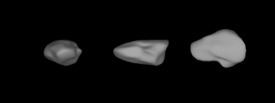Discovered by M. Lovas Alternative names 1982 BB Observation arc 12495 days (34.21 yr) Discovered 20 January 1982 Discoverer Miklos Lovas Discovery site Piszkéstető Station | Discovery date 20 January 1982 Aphelion 1.9021 AU (284.55 Gm) Orbits Sun | |
 | ||
Similar 1865 Cerberus, 4544 Xanthus, 2100 Ra‑Shalom, Solar System, 4183 Cuno | ||
3103 Eger is an Apollo and Mars-crosser asteroid that was discovered in 1982, by Miklós Lovas. It was named after the city of Eger, Hungary. It has an albedo of 0.64, making it a highly reflective asteroid.
It has made and will continue to make many close approaches to Earth. Its closest so far occurred in August 6, 1996, when the asteroid passed 0.11509 AU (17.217 Gm) from Earth.
3103 Eger is the only asteroid besides 4 Vesta identified as the parent body for specific meteorites. 4 Vesta is the parent body for Howardite, Eucrite, and Diogenite meteorites, while 3103 Eger is the parent body for Aubrite meteorites. In this characteristic 3103 Eger is related spectroscopically to the 434 Hungaria type asteroids, which are a Hirayama-family of orbital types, and E-type asteroids which form a spectroscopical type.
